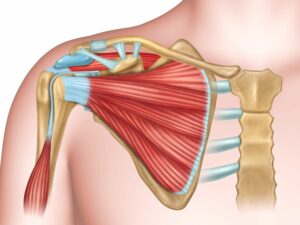Hemiplegic shoulder pain is a common yet often underestimated complication affecting individuals with hemiplegia, a condition characterized by paralysis of one side of the body. While the focus of rehabilitation is primarily on regaining motor skills, the significance of addressing hemiplegic shoulder pain cannot be overlooked. In this article, we delve into the causes, prevention, and management of this condition, shedding light on essential aspects that aid in promoting overall recovery.
Contents
Understanding Shoulder Anatomy

The shoulder is a complex and highly mobile joint that allows for a wide range of movements. It consists of several bones, muscles, tendons, ligaments, and other structures that work together to provide stability and mobility. Here’s an overview of the key components of shoulder anatomy:
Bones:
- Clavicle (Collarbone): A long, curved bone that connects the sternum (breastbone) to the scapula (shoulder blade).
- Scapula (Shoulder Blade): Triangular-shaped bone located on the upper back. It articulates with the humerus (upper arm bone) and the clavicle.
- Humerus: The bone of the upper arm that connects the scapula to the forearm bones (radius and ulna). It forms the ball-and-socket joint of the shoulder.
Joints:
- Glenohumeral Joint: This is the main joint of the shoulder, formed by the articulation of the head of the humerus and the shallow socket of the scapula called the glenoid. It provides the shoulder’s wide range of motion.
- Acromioclavicular Joint (AC Joint): The joint between the acromion process of the scapula and the clavicle. It allows for movement of the shoulder girdle and provides stability to the shoulder.
Risk Factors for Hemiplegic Shoulder Pain
he shoulder pain in this context often arises due to the complex interactions between altered muscle tone, joint instability, and positioning difficulties. Several risk factors contribute to the development of hemiplegic shoulder pain:
- Weakness and Imbalance: Hemiplegia results in muscle weakness on one side of the body. The imbalance in muscle strength can lead to improper movement patterns, overuse of certain muscles, and underuse of others. This imbalance can strain the shoulder joint and muscles, leading to pain.
- Muscle Spasticity and Contractures: Spasticity is a condition where muscles become overly tense and stiff due to disrupted communication between the brain and muscles. This can result in abnormal postures and muscle contractures, causing stress on the shoulder joint and surrounding structures.
- Shoulder Subluxation: The weakened muscles and altered muscle tone can lead to shoulder subluxation, where the humerus partially dislocates from the glenoid cavity. This misalignment can result in pain, inflammation, and damage to the joint.
Symptoms and Diagnosis
Symptoms of hemiplegic shoulder pain can vary in intensity and presentation but often include:
- Pain: Dull, achy, or sharp pain around the shoulder joint or upper arm, which may worsen with movement or certain positions.
- Stiffness: Reduced range of motion in the shoulder joint due to muscle stiffness and joint misalignment.
- Weakness: Difficulty in moving the affected arm due to muscle weakness and imbalanced muscle tone.
- Spasticity: Muscle stiffness and spasms, leading to abnormal postures and limited movement.
- Shoulder Subluxation: Sensation of the shoulder joint feeling unstable or loose, or visible partial dislocation of the humeral head from the glenoid cavity.
- Altered Sensation: Numbness, tingling, or altered sensation in the shoulder area or upper arm.
- Decreased Function: Difficulty performing daily tasks that involve the use of the affected arm, such as dressing, grooming, and reaching.
- Inflammation and Swelling: Swelling around the shoulder joint due to irritation of the tissues or joint structures.
Prevention of Hemiplegic Shoulder Pain

Diagnosis of hemiplegic shoulder pain involves a combination of clinical assessment, medical history review, and physical examinations. Healthcare professionals, often including neurologists, physiatrists, and physical therapists, play a crucial role in diagnosing and managing this condition. The diagnostic process may include:
- Medical History: Gathering information about the patient’s history of stroke or neurological condition, as well as the onset and characteristics of the shoulder pain.
- Physical Examination: Evaluating the patient’s shoulder mobility, muscle strength, muscle tone, joint alignment, and signs of spasticity or contractures.
- Imaging: X-rays, ultrasound, or magnetic resonance imaging (MRI) may be used to assess the shoulder joint’s structure, alignment, and the presence of any joint-related issues.
- Assessment of Muscle Tone and Spasticity: Healthcare professionals
Management and Treatment
Based on the evaluation, healthcare providers can then determine the underlying causes of the shoulder pain and develop a comprehensive treatment plan. Treatment strategies may include:
- Physical Therapy: Targeted exercises to improve muscle strength and joint range of motion, and correct muscle imbalances.
- Stretching and Range of Motion Exercises: Gentle stretching routines to prevent muscle contractures and improve flexibility.
- Modalities: Techniques such as heat, cold therapy, ultrasound, and electrical stimulation can help manage pain and improve tissue healing.
- Orthotic Devices: Customized slings or braces can provide support to the shoulder joint and promote proper alignment.
- Medications: Pain-relieving medications, muscle relaxants, or medications to manage spasticity may be prescribed.
- Injections: Corticosteroid injections or botulinum toxin (Botox) injections might be considered to alleviate pain and spasticity.
- Positioning and Postural Training: Learning proper sitting, lying, and transferring techniques to minimize stress on the shoulder joint.
- Functional Training: Working on tasks that involve the affected arm to improve functional independence.
Lifestyle Modifications
Lifestyle modifications can play a significant role in managing hemiplegic shoulder pain and improving overall well-being for individuals who have experienced a stroke or other neurological conditions leading to hemiplegia. These modifications focus on promoting joint health, preventing complications, and enhancing daily living. Here are some lifestyle adjustments to consider:
1. Maintain Good Posture:
- Practice proper alignment of the shoulder joint during sitting, standing, and lying down to reduce strain on the affected shoulder.
2. Regular Movement and Exercises:
- Engage in a gentle range of motion exercises and stretches to prevent muscle contractures and maintain joint flexibility.
- Work with a physical therapist to develop an exercise routine that targets muscle strength and joint stability.
3. Avoid Overexertion:
- Be cautious not to overuse the unaffected arm to compensate for the weaker side, as this can lead to strain and pain in the stronger shoulder.
4. Assistive Devices:
- Consider using adaptive tools or devices to assist with daily tasks, reducing the strain on the affected shoulder.
Long-Term Care and Monitoring
Long-term care and monitoring are essential for individuals with hemiplegic shoulder pain, especially those who have experienced a stroke or other neurological conditions resulting in hemiplegia. These measures help manage ongoing issues, prevent complications, and ensure the best possible quality of life. Here are some aspects to consider for long-term care and monitoring:
Regular Medical Follow-Up:
- Schedule regular appointments with your healthcare provider, neurologist, or physiatrist to monitor your overall health, assess any changes in your condition, and adjust your treatment plan as needed.
Physical and Occupational Therapy:
- Continue with regular physical therapy and occupational therapy sessions. These therapies can help maintain joint flexibility, muscle strength, and functional abilities.
Home Exercise Program:
- Work with your therapists to develop a home exercise program tailored to your needs. Consistent exercise can help prevent muscle atrophy, joint stiffness, and pain.
Alternative Therapies

Alternative therapies can complement traditional medical treatments in managing hemiplegic shoulder pain and improving the overall well-being of individuals with neurological conditions.
However, it’s important to consult with your healthcare provider before trying any alternative therapies to ensure they are safe and appropriate for your specific situation. Here are some alternative therapies that you might consider:
- Acupuncture: This traditional Chinese medicine practice involves inserting thin needles into specific points on the body to promote energy flow and alleviate pain. Some individuals find relief from shoulder pain through acupuncture.
- Massage Therapy: Therapeutic massage can help relax muscles, improve circulation, and reduce muscle tension and pain. Be sure to work with a massage therapist who is experienced in working with individuals who have neurological conditions.
- Yoga: Gentle yoga poses and stretches can help improve flexibility, balance, and body awareness. Look for classes or instructors who offer modifications for people with physical limitations.
- Tai Chi: This mind-body practice combines gentle movements, breathing, and meditation. Tai Chi can improve balance, coordination, and overall well-being.
- Aromatherapy: Certain essential oils, when used under guidance, might provide relaxation and pain relief. Lavender and peppermint are examples of essential oils that can have calming and soothing effects.
- Mindfulness and Meditation: These practices can help manage stress, improve relaxation, and enhance your ability to cope with pain and discomfort.
Conclusion
Hemiplegic shoulder pain is a significant concern that demands attention in the rehabilitation process. By understanding its causes, prevention methods, and management strategies, individuals can take proactive steps toward alleviating discomfort and promoting a more comfortable recovery journey.
If you’re experiencing Shoulder pain, physical therapy for shoulder pain at PhysioMantra can help: Book an online physical therapy session.



